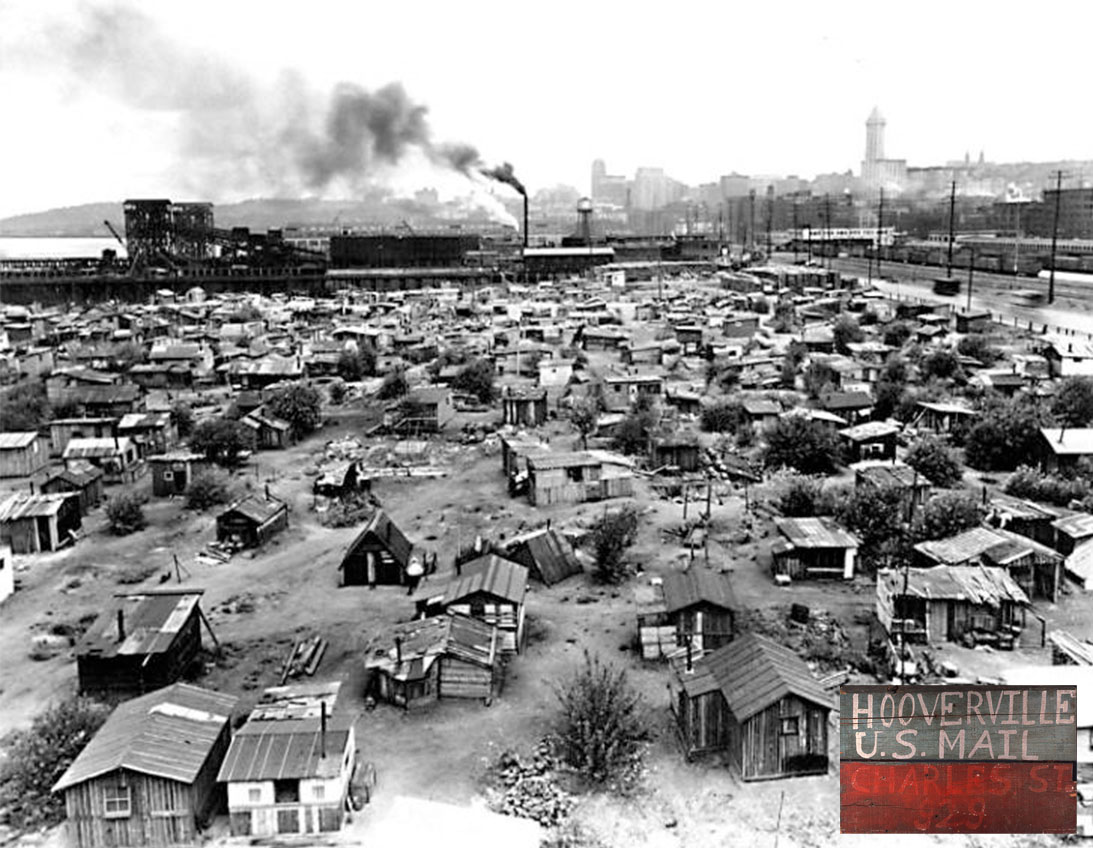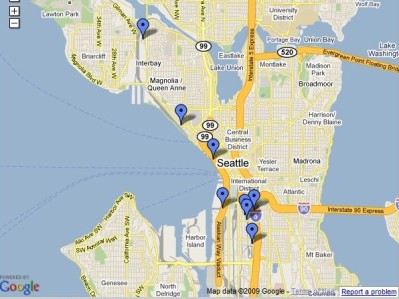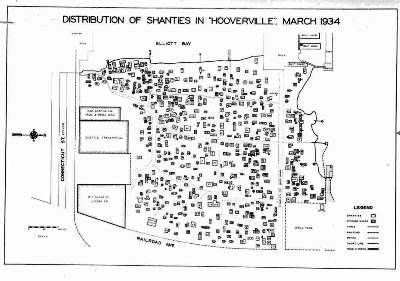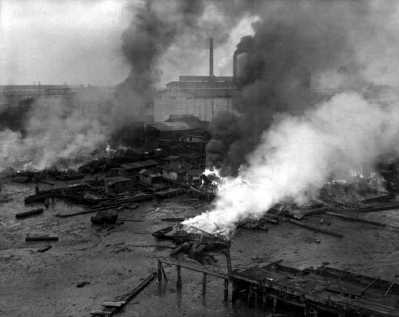Ohw Can We Prevent Hoovevilles From Poping Up Again
Hoovervilles and Homelessness

Click here to see more than photographs of Hoovervilles and homeless encampments in Seattle and Tacoma.
"Hooverville" became a mutual term for shacktowns and homeless encampments during the Great Low. At that place were dozens in the state of Washington, hundreds throughout the land, each testifying to the housing crunch that accompanied the employment crisis of the early on 1930s.
"Hooverville" was a deliberately politicized label, emphasizing that President Herbert Hoover and the Republican Party were to be held responsible for the economic crisis and its miseries.
Seattle's main Hooverville was one of the largest, longest-lasting, and best documented in the nation. Information technology stood for ten years, 1931 to 1941.
Covering 9 acres of public land, information technology housed a population of up to 1,200, claimed its own community regime including an unofficial mayor, and enjoyed the protection of leftwing groups and sympathetic public officials until the land was needed for shipping facilities on the eve of Globe War 2.
Seattle is fortunate to take the kind of detailed documentation of its Hooverville that other cities lack, and we have compiled these unique resources here. Included are photographs, city documents, a 1934 sociological survey of residents, a brusk memoir written by the quondam "mayor" of Hooverville, and more. We are grateful to the Seattle Municipal Archives, King County Archives, and the University of Washington Library Special Collections for permission to comprise materials in their collections.
Homelessness
Homelessness followed rapidly from joblessness once the economic system began to crumble in the early 1930s. Homeowners lost their property when they could non pay mortgages or pay taxes. Renters fell behind and faced eviction. Past 1932 millions of Americans were living outside the normal rent-paying housing market.
Many squeezed in with relatives. Unit densities soared in the early 1930s. Some squatted, either defying eviction and staying where they were, or finding shelter in one of the increasing number of vacant buildings.
And hundreds of thousands--no one knows how many--took to the streets, finding what shelter they could, nether bridges, in culverts, or on vacant public land where they built crude shacks. Some cities immune squatter encampments for a time, others did not.
Seattle's Housing Politics

Click to run across google map of shack towns in Seattle area and more photos and descriptions.In Seattle shacks appeared in many locations in 1930 and 1931, but authorities commonly destroyed them afterwards neighbors complained. What became the city's principal Hooverville started equally a group of footling huts on land side by side to Elliott Bay south of "sideslip road," equally the Pioneer Square area was then called. This was Port of Seattle holding that had been occupied past Skinner and Eddy shipyard during World State of war I. Today the nine acre site is used to unload container ships. It is just due west of Qwest Field and the Alaska Viaduct.
Seattle constabulary twice burned the early Hooverville, but each time residents rebuilt. When a new mayor took office in 1932, owing his election in part to back up of the Unemployed Citizen'due south League, Seattle's Hooverville gained a measure of official tolerance that allowed it to survive and grow.
Hooverville's Population

Donald Roy created this map of Seattle's Hooverville. Click the image to see a larger version of the map and here to read excerpts from Roy's sociological survey.By 1934 most 500 cocky-congenital one-room domiciles were "scattered over the terrain in insane disorder," according to Donald Roy, a sociology graduate student who studied the community. He counted 639 residents in March of that yr, all but 7 of them men. Most were unemployed laborers and timber workers, few of whom had held any jobs in the previous two years. It was a highly diverse population. Well-nigh were white with the majority of them foreign-born, especially Scandinavians. Nonwhites comprised 29% of the colony's population, including 120 Filipinos, 29 African Americas, 25 Mexicans, iv Native Americans, iv South Americans, and ii Japanese. Roy found the relaxed social atmosphere remarkable, describing "an ethnic rainbow" where men of many colors intermingled "in shabby comraderie."[ane]
The city imposed modest building and sanitation rules, required that women and children non alive in the Hooverville, and expected the residents to keep society. This was handled by an elected Vigilance Committee-- consisting of two whites, two blacks, and two Filipinos-- led by a white Texas native and former lumberjack named Jesse Jackson, who came to exist known as the unofficial "Mayor" of Hooverville. In 1938, Jackson wrote a brusk, brilliant description of the community that we reproduce here. He explained that the population was fluid, equally men sold their shacks to newcomers and moved on, and at its maximum during the winter months when information technology reached as hight every bit 1,200. He was proud of the self-built community, saying "Hooverville is the abode of the forgotten man." [2]

Tacoma's "Hollywood-on-the-Tideflats" was burned by metropolis officials in May 1942, but was before long reoccupied and rebuilt. Courtesy Tacoma Public Library. Other Hoovervilles likewise developed: i on the side of Beacon Hill where today I-5 passes; 1 in the Interbay area next to where the city used to dump its garbage; and ii others along sixth Avenue in S Seattle. In belatedly 1935, the city Health Department estimated that iv,000 to v,000 people were living in the various shacktowns.[three]
The city tolerated Hoovervilles until the eve of World State of war II. Early in 1941, the Seattle Health Section established a Shack Emptying Committee to identify unauthorized housing clusters and program their removal. A survey located 1687 shacks in five substantial colonies and many smaller ones. In April, residents of the main Hooverville were given detect to get out by May ane. Police officers doused the little structures with kerosene and lit them every bit spectators watched. Seattle's Hooverville had lasted a full decade.[iv]
Tacoma's Hooverville
Shanty towns as well appeared in or near other cities. Tacoma hosted a large encampment nearly the urban center garbage dump that residents called "Hollywood-on-the-Tideflats." Past the end of the decade it covered a 6 block area and, like Seattle'southward Hooverville, included a large number of trivial houses that residents had built out of bit materials and steadily improved over the years. City officials alternately tolerated and tried to eradicate the shack boondocks. In May 1942, shortly subsequently Seattle destroyed its Hooverville, the Tacoma Burn down Department burned fifty of the "Hollywood" shacks. But residents rebuilt and the site remained occupied all the way through World War II.
Copyright (c) 2009, James Gregory
Next: Unemployed Citizens League and Poverty Activism
Hither is more on Hoovervilles:
Enquiry Reports | |
 | Seattle's "Hooverville": The Failure of Effective Unemployment Relief in the Early 1930s by Magic Demirel "Hoovervilles," shanty towns of unemployed men, sprung upward all over the nation, named later President Hoover'southward insufficient relief during the crisis. Seattle's developed into a self-sufficient and organized boondocks-within-a-town. |
 | A Tarpaper Carthage: Interpreting Hooverville, by Joey Smith Seattle's Hooverville and its residents were portrayed as tearing, exotic, and separate from the residual of Seattle, obscuring the social accomplishments and self-arrangement of shantytown residents. |
 | "Nobody Paid whatsoever Attention": The Economical Marginalization of Seattle's Hooverville, by Dustin Neighly Seattle'southward decision to raze Hooverville in 1941 and expel its residents relied on a soapbox of "otherness" that set up Hooverville economically, socially, and geographically apart. |
 | Self-Help Activists: The Seattle Branches of the Unemployed Citizens League past Summertime Kelly In the summer of 1931 a group of Seattle residents organized to establish self-assistance enterprises and demand that regime officials create jobs and increase relief help to unemployed. |
 | Organizing the Unemployed: The Early on 1930s by Gordon Black As elsewhere in the land, Washington State's Communist Party helped to organize the unemployed into active political and social formations. In Washington, the Unemployed Citizen's League and its newspaper, The Vanguard, gained the land Communists a broad appeal, and integrated the unemployed into the state's radical reform coalitions. |
Primary Source Documents | |
 | The Story of Seattle'south Hooverville by Jesse Jackson, "Mayor" of Hooverville |
 | Hooverville: A Written report of a Community of Homeless Men in Seattle by Donald Francis Roy Roy lived in the Hooverville in leap 1934 while conducting this survey which became his 1935 MA thesis. He offers fascinating observations about social mores and civilisation of the customs, including the easy racial relations and tolerance of homosexuality. |
 | Seattle Municipal Archives Documents Petition for customs bathroom houses in Hooverville (May 15, 1935) |
Notes
[1] Donald Francis Roy, "Hooverville: A Study of a Community of Homeless Men in Seattle," (Thou.A. Thesis, University of Washington, 1935), pp.42-45
[2] Jesse Jackson, "The Story of Seattle's Hooverville," in Calvin F. Schmid, Social Trends in Seattle (Seattle: University of Washington Press, 1944), 286-93.
[3] Report of the Sanitation Divison December 31, 1935 as quoted in Excerpt from the Health Department Almanac Report 1935, Seattle Municipal Athenaeum: http://www.seattle.gov/CityArchives/Exhibits/Hoover/1935ar.htm (accessed December 29, 2009)
[4] Report of Shack Elimination Committee (April fourteen, 1941), Seattle Municipal Athenaeum (accessed December 29, 2009)
Source: https://depts.washington.edu/depress/hooverville.shtml
0 Response to "Ohw Can We Prevent Hoovevilles From Poping Up Again"
Post a Comment